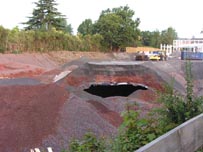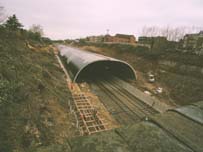Gerrards Cross
26 Aug 2005
Rail tunnel collapse
 At thirty-four minutes past seven on the evening of Thursday June 30th, the driver of a Chiltern train service, between Stratford-upon-Avon and London Marylebone, stopped at Gerrard’s Cross station. He reported that part of the new Tesco Tunnel over the railway had collapsed! The implications and potential consequences if a train had been under the new tunnel at the time of the collapse, don’t bear thinking about!
At thirty-four minutes past seven on the evening of Thursday June 30th, the driver of a Chiltern train service, between Stratford-upon-Avon and London Marylebone, stopped at Gerrard’s Cross station. He reported that part of the new Tesco Tunnel over the railway had collapsed! The implications and potential consequences if a train had been under the new tunnel at the time of the collapse, don’t bear thinking about!
But you had to look hard to find any reference in the media. News of the collapse was ‘buried’ under the ‘Make Poverty History’ concerts and the build up to the Gleneagles G8 Summit talks, not to mention Wimbledon tennis. The announcement of London’s successful Olympic bid, followed by the terrorist bombings ensured even less coverage of the start of the clean up operation and investigation.
Tesco Stores, Network Rail, contractors Jackson Civil Engineering and their design consultants White Young Green and Partners must all be pleased that this bad news was so effectively buried!
20,000 square feet plus parking on top
The Chiltern line runs from London Marylebone through Beaconsfield, Banbury and on to Birmingham. The construction of the 320 or 350 metre long tunnel (press releases are inconsistent on the length) is controversial. Local protesters are concerned that the new Tesco store and car park, which were planned to sit on top of the tunnel, would attract too much new road traffic to the area and indeed, at least one objector expressed the view that the ground was too soft to support the proposed concrete arch cover!
The plan was for a new store with 20,000 square feet of selling space and car parking. The tunnel proposal from Tesco Stores was made due to the lack of available land in the area. The site is between Packhorse Road Bridge and Marsham Lane Bridge in Gerrard’s Cross.
5,000 tons or more to dig out
Jackson Civil Engineering is the principal contractor for the £20.3 million design and build project, with a contract programme of 108 weeks. White Young Green are the design consultants. The proposed construction is pre-cast concrete arch members supported on piled foundations and covered by approved fill material.
The collapsed section of tunnel is some 30 metres in length, starting about 80 metres in from the south end tunnel portal. Initially, Tesco reported that the arches had collapsed under the weight of fill with an estimated 100 tons of material on the track. However, after a two day first assessment, Network Rail advised that there was an estimated 5,000 tons of material to be dug out, with spoil up to six metres deep in places. They have pledged to work night and day to re-open the line and get trains running again, but first estimates are that this will take several weeks.
 Designed for up 200 mm deflections
Designed for up 200 mm deflections
Jackson’s contract includes the creation of a land platform over the tunnel, together with the provision of roads and services, as well as the car park. Prior to the collapse, 450 mm diameter cast in-situ concrete foundation piles had been installed. The pile-capping beam was cast with a 100 mm deep trough 375 mm wide, into which each segment was grouted.
The design required the segments to be staggered so that each half span unit bears on two from the other side of the span. Staging was used to support the first half dozen units, after which the system was stable enough for the remainder to be stable without additional support. The 350 mm thick and 2 metre wide half span segmental arch units were designed and supplied by the Reinforced Earth Company, a subsidiary of Freyssinet.
This system has been used in France for a decade, and its design is based on a three pin arch principle with segments connected at the centre top using a male/female stainless steel faced pin joint. The design’s flexibility allows up to 200 mm of vertical movement.
Short five hour shift possessions
The 340 Techspan precast concrete arch units had been erected during short five-hour night shifts, with on average just four segments being erected in each possession. This element of the contract was undertaken by PCE Ltd, who are specialists in this type of work. Their 17-week contract with Jackson’s, included the use of PCE’s own LR1160 crawler crane, which was purchased for this contract. All fill material was imported by rail at the insistence of the local authority. Limestone scalpings from Whatley Quarry in the Mendip Hills, Somerset were used for the sides, and the first 1.5 metres of top cover to the arches.
200,000 tons of fill from Hanson Aggregates
A total of around 120,000 tons of this material was supplied by Hanson Aggregates and brought into an extended existing siding in 1,000-ton trainloads. Above this a top layer of graded incinerator bottom ash, 80,000 tons of it again supplied by Hanson Aggregates and brought to site by rail, was being used. This material is a successful recycling project, with this ill-fated job being the largest ever order for the material in UK. Limestone deliveries started last October and were due for completion in May. The fill was placed and compacted in 500 mm layers.
Monsoon rainfall the day before
New Civil Engineer magazine, 7th July edition, expressed the opinion that the collapse was triggered by an imbalance in the placement and compaction of the fill, combined with a surcharge of fill over the tunnel crown. This situation is evident from the photographs printed in that magazine.
The area did suffer from monsoon like rainfall on the Wednesday, just one day before the collapse. Designers of precast arch systems stress the importance of filling evenly starting around the sides. Movement around the crown of as much as 200 mm need not be a cause for concern, so long as the filling is controlled adequately both over the arches and along the length.
It could have been much, much worse!
Doubtless, unexpected information will come out of the inquiries by both Network Rail and the Inspectorate, but the damage to public opinion of the competence of rail engineers may suffer less than some might fear, due to other items of bad news.
Meanwhile, Tesco still want to see their new supermarket completed and someone is going to have to pay the bill for blocking the railway and clearing up the mess after the collapse. But it could have been much, much worse!
